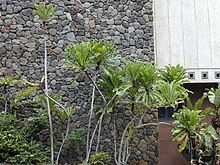|
Ficus pseudopalma
Ficus pseudopalma is a species of fig, (subgenus Sycamorus) in the mulberry family (Moraceae).[1] It is known by the common names Philippine fig, dracaena fig, and palm-leaf fig.[2] In nature it is endemic to the Philippines, especially the island of Luzon.[2] It is known elsewhere as an ornamental plant. This is a shrub or rarely branching small tree growing erect with a naked unbranched mesocaul stem topped with a cluster of wavey-edged leaves to give it the appearance of a palm.[3] Indeed, the species name pseudopalma means "false palm".[4] The leaves are up to 30 -36 inches (75–90 cm) long[5] with a yellow midrib and edged with dull teeth. The edges of the leaf are elevated above the midrib, forming a sort of trough.[6] The fruit is a dark green fig that grows in pairs, each fruit just over an inch long.[3] In Luzon, this plant occurs in grassland and forest habitat, where it is considered common.[7] The new shoots of the plant are eaten as a type of vegetable, and there are a number of traditional medicinal uses, such as a remedy for kidney stones made from the leaves.[8] In Bicol Region the plant is known as Lubi-lubi and the leaves are cooked in coconut milk.[4] In 2003 the leaves were sold in markets for US$0.74 per kilogram, and the plant can be grown in plantations without pesticides for an adequate profit.[4] This shrub has been used as a landscaping plant in Hawaii, but it never escaped cultivation or became established in the wild because the species of wasp that pollinates it was never brought to the islands.[3] ReferencesWikimedia Commons has media related to Ficus pseudopalma.
|
||||||||||||||||||||||||||||||||||
